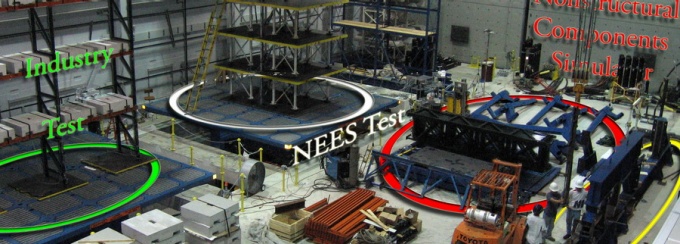History

We launched in 1983 and then expanded in 2003 through grants by the National Science Foundation. Since then, the laboratory has grown and expanded in both size and research capabilities.
Establishment
The Structural Engineering and Earthquake Simulation Laboratory (SEESL) was established in 1983 on UB's North Campus as a successor to the Structural Engineering Laboratory (SEL), which was located on the UB South Campus. This new laboratory was equipped with an advanced 5-degree-of-freedom 50 ton capacity shake table. The development of SEESL was a culmination of the vision of the late Professor Robert L. Ketter (former UB president) and Professor George C. Lee (CSEE Emeritus Professor and former dean of the UB School of Engineering and Applied Sciences). Under the leadership of the late Professor John Neal (SEESL’s first director), the laboratory was equipped with state-of-the-art hardware and instrumentation to support structural and earthquake engineering research.
The demonstrated capabilities of SEESL led to the establishment of the National Center for Earthquake Engineering Research (NCEER), headquartered at UB and funded by the National Science Foundation (NSF), in 1986. NCEER and SUNY funding facilitated the expansion of the physical footprint and technical capabilities of the laboratory beginning in 1989.
For 20 years, SEESL was the flagship laboratory of NCEER and its successor entities. During that period, with sustained funding for management, operations and maintenance from NCEER (later called MCEER, substituting “Multidisciplinary” for “National”), the laboratory facilitated advanced research and testing without the burden of laboratory operations and maintenance expenses. The first experiments utilizing active control devices and systems were performed at this time. This resulted in a new field of research and led to the implementation of real-world applications in Japan. Similarly, pioneering experiments in advanced base isolation systems, experiments on passive and semi-active energy dissipation devices, and testing of retrofit solutions reinforced concrete and steel structures, led to the development of a new field of earthquake resistant design: aseismic protective systems.
In 1996, Professor Michael C. Constantinou assumed responsibility as SEESL director and established an industry service program, supporting seismic qualification programs, component testing, R&D and other needs of companies such as Taylor Devices, Enidine Corporation, Jarret Corporation, FPS Corporation, DIS Ltd., RJ Watson Inc., Moog Corporation, IBM Corporation and others. This program resulted in the development new products for the protection of structures and nonstructural equipment against seismic effects. SEESL continues to provide seismic qualification services to an expanding group of national and international industry clients.
Expansion
In 1998, Professor Michel Bruneau (MCEER Director), Professor Andrei M. Reinhorn (CSEE Chair), and Professor Michael Constantinou, envisioned a plan and laid the groundwork for the development of a new, versatile facility that would combine real-time testing and computational simulations. In 1999, with the assistance of the University at Buffalo’s administration, the team developed a successful proposal that resulted in the awarding of two NSF grants, establishing SEESL as one of 16 university-based laboratories comprising the Network for Earthquake Engineering and Simulation (NEES). These grants facilitated a major expansion of SEESL, which included the development and installation of new state-of-the-art equipment housed in a 4,000 square foot building expansion supported by the SUNY Construction Fund and the University at Buffalo. The cost of the expansion was $21.2 million dollars. Planning for the expansion started in 2000, and construction began in 2002. The expanded laboratory began operations in mid-2004, and the NEES Consortium was officially launched in October of that year. The facility added two new relocatable 6-degree-of-freedom 50 ton shake tables, advanced large scale dynamic and static actuators, a geotechnical laminar box, and networked controllers interfaced to a high speed local area network which supported the development and implementation of a unique capability involving integrated physical and computational simulations. Operations and maintenance funding was provided for 10 years by NSF through the NEES award, which terminated at the end of September 2014.
What's Happening Now
SEESL continues to offer testing services for industry clients, research sponsors (both domestic and international) and CSEE department-funded instructional and research activities. Support from CSEE, SEAS and UB for the management, operation, and maintenance of the facility, combined with funding from industry clients and research sponsors, allows SEESL to continue as a leader in the field of earthquake engineering and simulation.